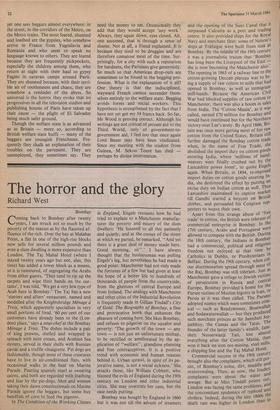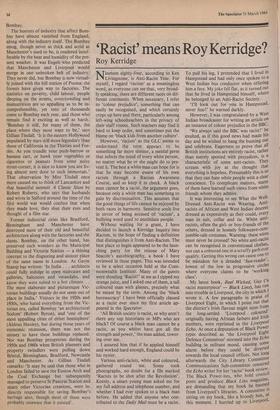The horror and the glory
Richard West
Bombay (Morning back to Bombay after twenty N./years, I am struck not so much by the poverty of the masses as by the flaunted af- fluence of the rich. Over the bay at Malabar Point, a flat in one of the high-rise blocks now sells for several million pounds and even a slum dwelling is more expensive than London. The Taj Mahal Hotel (where I stayed twenty years ago but not, alas, this time) has added a tower block as a means, so it is rumoured, of segregating the Arabs from other guests. 'They tend to rip up the carpets and wipe their hands on the cur- tains', I was told. 'We get a very low type of Arab here in Bombay.' The Taj has a new 'starters and afters' restaurant, named and modelled after the Knightsbridge Ménage a Trois, which apparently specialises in very small portions of food. '60 per cent of our customers have already been to the (Lon- don) place,' says a sous-chef at the Bombay Ménage a Trois. The dishes include a pair of king prawns, shelled and wrapped in spinach with mint cream, and Arabian Sea oysters, served in their shells with Russian caviar and a truffle vinaigrette. Pet dogs are fashionable, though most of these creatures have to live in air-conditioned flats, with occasional walks in the heat on Marine Parade. Panting spaniels snarl at sweating cairns, and both are regarded with loathing and fear by the pie-dogs. Men and women taking their dawn constitutionals on Marine Parade ignore the beggars, but some buy handfuls of corn to feed the pigeons.
In The Condition of the Working Classes in England, Engels recounts how he had tried to explain to a Manchester manufac- turer the poverty and misery of the slum dwellers: 'He listened to all this patiently and quietly, and at the corner of the street at which we parted, he remarked, "And yet there is a great deal of money made here. Good morning, sir".' I have always thought that the businessman was pulling Engels's leg, but nevetheless he had made a good point: Manchester had not only made the fortunes of a few but had given at least the hope of a better life to hundreds of thousands of people from the countryside, from the ghettoes of central Europe and from Ireland. The analogy with Manchester and other cities of the Industrial Revolution is frequently made in Gillian Tindall's City of Gold: The Biography of Bombay, a fine and provocative book that enhances the pleasure of coming here. She likes Bombay, and refuses to pilgerise on the squalor and poverty: 'The growth of the town — any town — is not just an unfortunate mishap, to be rectified or ameliorated by the ap- plication of "welfare", grandiose planning and free contraceptives. It is a positive trend with economic and human reasons behind it. Urban sprawl, in spite of its pe- jorative name, is not a social sickness.' She attacks those, like William Cobbett, who blamed the evils of England during the 19th century on London and other industrial cities. She may overstate her case, but the case needs putting.
Bombay was bought by England in 1660 but it was not till the advent of steamers
and the opening of the Suez Canal that it surpassed Calcutta as a port and trading centre. It also provided ships for the Royal Navy and merchant fleet: some of Nelson's ships at Trafalgar were built from teak at Bombay. By the middle of the 19th century it was a journalistic truism that 'Bombay has long been the Liverpool of the East — she is now becoming the Manchester also.' The opening in 1863 of a railway line to the cotton-growing Deccan plateau was to br- ing a supply of raw cotton to mills that had opened in Bombay, as well as immigrant milt-hands. Because the American Civil War had blocked supplies of raw cotton to Manchester, there was also a boom in sales from India. The 'Cotton Mania', as it was called, earned £70 million for Bombay and would have continued but for the Northern victory over Lee's army. By April 1866, Bri- tain was once more getting most of her raw cotton from the United States. Britain still further damaged the Bombay cotton trade when, in the name of Free Trade, she abolished the import duty on cotton goods entering India, where 'millions of hand- weavers were finally crushed out by the Lancashire power loom', to quote Engels again. When Britain, in 1894, re-imposed import duties on cotton goods entering In- dia, she destroyed the effect by putting an excise duty on Indian cotton as well. Thus Lancashire maintained its captive market till Gandhi started a boycott on British clothes, and persuaded his Congress sup- porters to weave their own. Apart from this strange abuse of 'free trade' in cotton, the British were tolerant of commercial enterprise in Bombay. In the 17th century, Arabs and Portuguese were allowed to compete with the British. During the 18th century, the Indians in Bombay had a commercial, political and religions freedom not enjOyed at that time by Catholics in Dublin, or Presbyterians in Belfast. During the 19th century, when col- our discrimination spread through most of the Raj, Bombay was still tolerant. Just as Manchester gave a refuge to Jewish victims of persecution in Russia and central Europe, Bombay provided (a home for the Parsee victims of Muslim bigotry in Iran, or Persia as it was then called. The Parsees adopted names which were sometimes com- ical — such as Readymoney, Boatwallah and Sodawaterwallah — but they produced such merchant princes as Sir Jamsheti Jee- jeebhoy, the Camas and the Tatas. The founder of the latter family's wealth, Jam- sheti Nusserwanji Tati, lost almost everything after the Cotton Mania, tt.lert won it back on iron ore mining, steel mills, a shipping line and the Taj Mahal Hotel. Commercial success in the 19th centurY brought also the complaints, which still per- sist, of Bombay's noise, dirt, muddle and overcrowding. Then, as now, the loudest complaints were about the water and sewage. But as Miss Tindall points out, London was facing the same problems, and the concomitant epidemics of typhoid and cholera. Indeed, during the late 1860s the death rate was higher in London than in
Bombay.
The horrors of industry that affect Bom- bay have almost vanished from England, along with the industry itself. The Bombay smog, though never as thick and acrid as Manchester's used to be, is rendered insuf- ferable by the heat and humidity of the pre- sent weather. It was Engels who predicted that Manchester and Liverpool would merge in one unbroken belt of industry. They never did, but Bombay is now virtual- ly joined with the hill station of Poona: the forests have given way to factories. The statistics on poverty, child labour, people sleeping on the streets, overcrowding and malnutrition are so appalling as to be in- comprehensible, yet tens of thousands come to Bombay each year, and those who remain find it exciting as well as harsh. 'Bombay is still, for many of them, the place where they most want to be,' says Gillian Tindall. 'It is the eastern Hollywood populated by stars still more legendary than those of California in the Thirties and For- ties. As you trundle your push-barrow or banana cart, or hawk your vegetables or cigarettes or peanuts from some noisy street-corner, it is nice to know you are liv- ing almost next door to such immortals.' That observation by Miss Tindall once more caused me to think of Lancashire and that beautiful memoir A Classic Slum by Robert Roberts, who says that husbands and wives in Salford around the time of the first world war would confess that when they made love, they shut their eyes and thought of a film star.
Former industrial cities like Bradford, Birmingham and Manchester have destroyed most of their old and beautiful architecture along with the factories and the slums. Bombay, on the other hand, has preserved such wonders as the Municipal Building and Victoria Station — a shining contrast to the disgusting and sinister place of the same name in London. As Gavin Stamp has written: 'In India . . . architects could fully indulge in open staircases and galleries, balconies and verandahs, and know they were suited to a hot climate... The most elaborate and picturesque Vic- torian buildings usually do not seem out of place in India.' Visitors in the 1920s and 1930s, who hated everything from the Vic- torian era, called Bombay 'an architectural Sodom' (Robert Byron), and 'one of the most appalling cities of either hemisphere' (Aldous Huxley), but during those years of economic recession, there was not the money to have these buildings replaced. Nor was Bombay prosperous during the 1950s and 1960s when British planners and property swindlers were pulling down Bristol, Birmingham, Bradford, Newcastle and Manchester. As Gillian Tindall remarks: 'It may be said that those who in London failed to save the Euston Arch and the Coal Exchange but subsequently managed to preserve St Pancras Station and many other Victorian creations, were in- directly responsible for saving Bombay's heritage also, though most of them were probably unaware that it existed'.















































 Previous page
Previous page